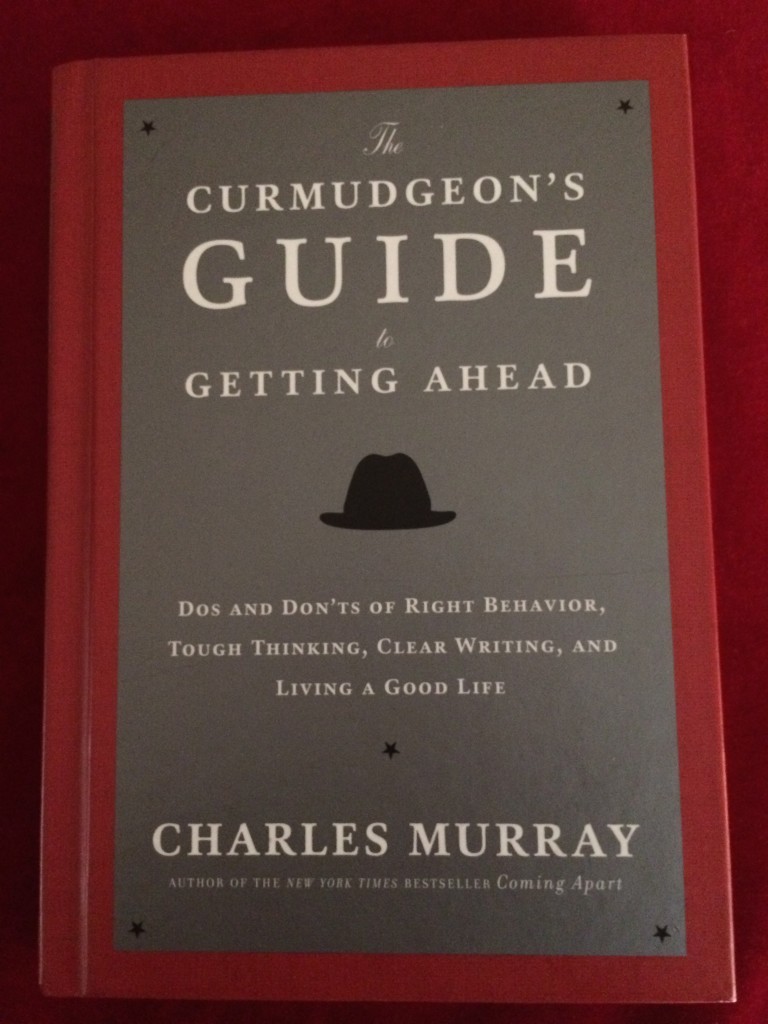 What is a curmudgeon and how do you know if you are one? Perhaps a good place to start would be with Charles Murray‘s book, The Curmudgeon’s Guide to Getting Ahead (2014), a brief read about the “Do’s and Don’ts of Right Behavior, Tough Thinking, Clear Writing, and Living a Good Life.”
What is a curmudgeon and how do you know if you are one? Perhaps a good place to start would be with Charles Murray‘s book, The Curmudgeon’s Guide to Getting Ahead (2014), a brief read about the “Do’s and Don’ts of Right Behavior, Tough Thinking, Clear Writing, and Living a Good Life.”
Filled with “tricks” – i.e. tips and suggestions – with a particular focus on young people as they navigate the treacherous waters from college to adult life, The Curmudgeon’s Guide is an “indispensable sourcebook for living an adult life” and a lasting treat that deserves a special place on the bookshelf as a timeless reference, of course, only if you ARE a curmudgeon.
Murray goes beyond the technical definition of a curmudgeon as an “ill-tempered man,” and offers a more broad description that encompasses “highly successful people of both genders who are inwardly grumpy about many aspects of contemporary culture, make quick and pitiless judgments about your behavior in the workplace, and don’t hesitate to act on those judgments in deciding who gets promoted and who gets fired.”
Curmudgeons, Murray writes, “usually don’t give off many clues that they’re doing these things…because they want to be polite, but also because they don’t want to sound like geezers, old and out of touch.”
While Murray might be a curmudgeon – and yes, he is older – he is certainly not out of touch. As a lifelong social historian, he started supplementing his colleagues’ online tips for interns and entry-level staff on grammar and English usage with a “series on proper behavior in the workplace.” Murray was responding to what he saw as a decline in the deterioration of manners. His book evolved from this and is a polite curmudgeonly gesture towards rectifying the current landscape.
In his introduction, he writes: “As The Curmudgeon’s Guide to Getting Ahead moves from success in the workplace into the deeper waters of success in living, you will find the occasional bromide, because some of the clichés you’ve been hearing all your life are actually true and need to be considered afresh.”
From “On the Presentation of Self in the Workplace” (Don’t Suck Up) to “On Thinking and Writing Well” (Putting together your basic writing toolkit) and “On the Pursuit of Happiness” (Take religion seriously even if you’ve been socialized not to), Murray delivers plenty of things to consider afresh and does so with a tough, albeit polite, matter-of-fact and sometimes humorous manner, some of which you’ll find below.
Take, for instance, the commonplace use of the phrase “no problem” instead of “it is my pleasure” or “you’re welcome.” A seemingly benign phrase on the surface, Murray explores it in depth to show how its use signals a “retreat from graciousness.”
“When you unpack ‘No problem,’ what people are saying is: ‘I can do what you’ve asked because it will not unduly burden me,’” Murray writes. “Graciousness is good” and the phrase “No problem”, he explains, is not gracious – and “[i]t is much more pleasant to live in a world where people are gracious.”
Murray goes on to denounce a prevailing ethos of nonjudmentalism, writing: “Of the many precocious aspects of today’s academic culture, I think the worst is its celebration of nonjudgmentalism.” He continues: “The ability to make judgments is what distinguishes Homo sapiens from every other living creature…[b]ut the ability to make judgments carries with it the obligation to do so. You don’t have a choice.”
In defining “judgmental,” he writes: “The negative connotations of judgmental – harsh, arbitrary, condemnatory moral judgments – have taken over so completely that I can’t recall the last time I heard judgmental used in a neutral sense. But historically (and still in some dictionaries), the first meaning of judgmental was simply ‘of, relating to, or involving judgment.’”
Another interesting change that Murray examines is the use of first names with people considerably older than oneself. “The use of first names has undergone a cultural transformation in the last three or four decades” (he again rightfully blames the baby boomers and their fear of being grown-ups), he writes, “so that by now the use of honorifics and last names is nearly extinct.”
Turning to James Madison and Thomas Jefferson as an example, he writes: “Their friendship was deep and intimate. And yet the last letter from Jefferson to Madison, written less than a month before Jefferson’s death, begins not with ‘Dear Jemmy’ (Madison’s nickname), but with ‘Dear Sir.’”
In our curmudgeonly opinion, Mr. Murray could have elaborated more on the ramifications of this transformation in regards to the blurring of generations (this is something that is now being written about) and the relationship to the notions of honor and respect.
But, we will be polite with our judgment of Mr. Murray’s book and say that there is something to glean in this guide – Curmudgeon or not – for anyone who is interested in self-improvement, which is most assuredly necessary for living a good and gracious life.
Of Interest: One of our most curmudgeonly irritations (from growing up with an English teacher as a mother/grandmother) was shared by Charlotte Hays, a reviewer of Mr. Murray’s book who wrote:
“As much as I like Mr. Murray’s tips, I regret that he didn’t address what I regard as the most horrific (and revealing) grammatical error afoot in the land: ‘he,’ ‘she,’ and ‘I’ for ‘him,’ ‘her,’ and ‘me.’ It isn’t the uneducated but graduates of good schools who nowadays say, ‘I gave it to Jim and he.’ This betrays a certain unfamiliarity with grammar – and thus with the process of thinking itself.”
This isn’t the first book of Murray’s we’ve reviewed. See our review of Charles Murray’s By The People: Rebuilding Liberty Without Permission.
